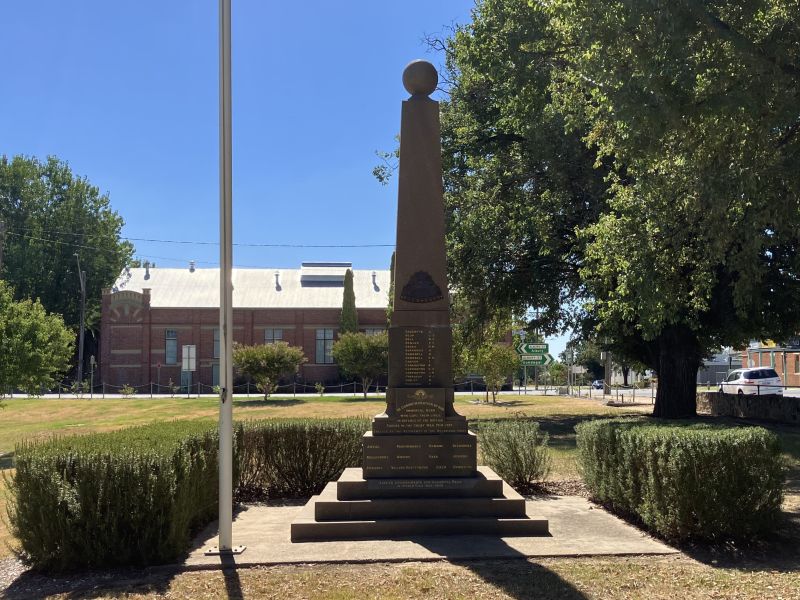Leslie James Hitchcock
Leslie was born in 1890 at Junee, New South Wales. He was one of nine children to Andrew and Elisabeth (née Mulley) Hitchcock. The 1912 and 1913 Electoral Rolls have Leslie listed as a labourer living in Walwa/Jingellic area.
The 18th of February 1916 issue of the Government Gazette of the State of New South Wales lists Leslie as having passed his examination to become a Class 3B state school teacher. It’s not known whether he was allocated a school as, two weeks later, he enlisted at Cootamundra in New South Wales. He was allocated the Regimental Number 6022 and joined the 19th Reinforcements for the 4th Battalion of the 1st Brigade, the 1st Australian Division. Prior to embarking overseas, Leslie attended a farewell presentation in Holbrook. The 12th of June 1916 edition of The Border Morning Mail and Riverina Times described the scene.
“HOLBROOK
On Wednesday evening, several gentlemen assembled at the School of Arts supper room, to make presentations to a number of soldiers leaving for the front. Rev. J. N. McGee, chairman of the Holbrook Soldiers’ Reception Committee presided, and on his right were the soldiers, some going to the front, and two Anzacs, The chairman presented Privates Harry Inwood, Wm. Lunt, and Leslie Hitchcock with silver cigarette holders, and Privates Arthur H. Hill and A. E. Smith with wristlet watches. The usual toasts were honoured, and the guests responded.
The two Anzacs - Private E. Roy Howarth and Recruiting Sergeant Cridland - also gave brief addresses. Messrs. John J. Bowler and John C. Bowler rendered songs.”
Leslie embarked on HMAT A18 Wiltshire on the 22nd of August 1916 at Sydney. The day after sailing he was admitted to the Ship’s hospital suffering from VD. He remained there for six days. Five weeks after leaving Sydney they disembarked at Plymouth in the U.K. He spent the next six weeks as part of the 1st Training Battalion, developing his skills and knowledge of fighting techniques he would need at the front.
The 19th Reinforcements boarded the SS Arundel at Folkstone on the 13th of December and sailed to France. The following day they marched into the 1st Australian Division Base Depot at Etaples in France. Two days later he was admitted to the 26th General Hospital suffering from tonsillitis. Four days later he was discharged and, along with the rest of the 19th Reinforcements, joined the 4th Battalion.
On the 8th of May 1917 he was seriously wounded in action, receiving gunshot wounds to the head and right arm. Over the next two days he was transferred to the 5th Field Ambulance, then the 3rd Casualty Clearing Station and finally the 47th General Hospital back in England. By the 16th of May he was recovering in the Brook War Hospital at Shooters Hill Road in Woolwich. On the 8th of June he was transferred to the 3rd Auxiliary Hospital at Dartford. Leslie would not be released from hospital until the 31st of August. He was not returned to his battalion but was attached for duty with the Australian Provost Corps (Military Police), Codford Detachment. On the 8th of June, over one year since he had been wounded, he rejoined the 4th Battalion at Rouen in France but remained as part of the Provost Corps.
The 4th Battalion would participate in the Allies' great offensive of 1918. Launched on the 8th of August, just east of Amiens, the advance this day by Allied forces was the greatest success in a single day on the Western Front. The German General, Eric Ludenorff, would describe it as the blackest day for the German Army of the entire war.
Lieutenant G.R. Freer, the officer in charge of prisoner movement, describes what happened on the 8th of August.
“Killed in Action 8/8/18
Informant described Hitchcock as 5 feet 9 inches high, well built, dark complexion, aged in the twenties. He had an impediment in his speech.
Informant states that on the 8th or 9th of August last, he was in command of a convoy of about 1000 German prisoners, Hitchcock being under his orders. While Hitchcock was engaged in his duties, he was hit when just outside Harbonnieres by an enemy aeroplane bomb. Informant saw his fall from his horse, and went over to him to render first aid. He died in the presence of informant, about 10 minutes after being hit. He was buried that night in a small military cemetery outside Harbonnieres. The grave was fixed up later with a small wooden cross with his name etc., on a bit of tin affixed thereto, and informant saw it.
According to Informant, Hitchcock was a well liked chap. He was booked to go to England in a few days, for the purpose of being married.”
Leslie was buried in Heath Cemetery, Harbonnieres, France. He is also remembered on the Australian War Memorial Roll of Honour, the Walwa Roll of Honour, and the Holbrook War Memorial. For his service during the war he was awarded the British War Medal, and the Victory Medal.
In January of 1917, Leslie’s parents gave his younger brother, Walter Stanley Hitchcock permission to enlist. Although seriously wounded, Walter returned to Australia accompanied by his new English bride, Hettie.

 Stephen Learmonth
Stephen Learmonth